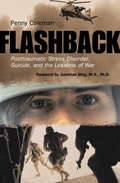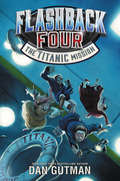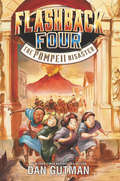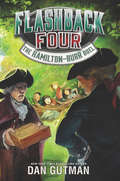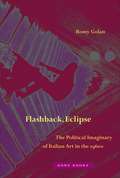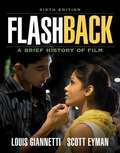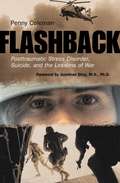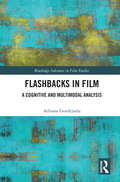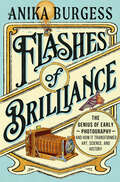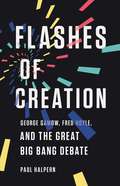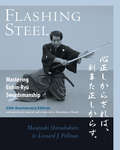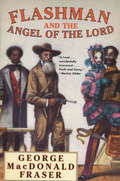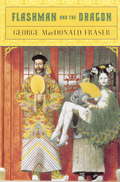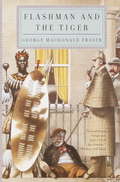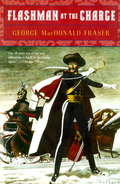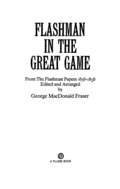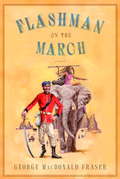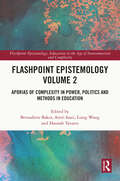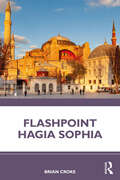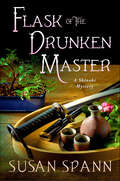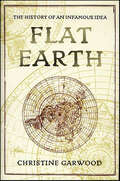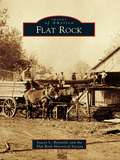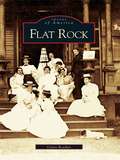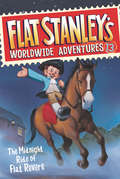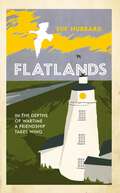- Table View
- List View
Flashback
by Penny ColemanWith the recent wars in Afghanistan and Iraq, once again America's men and women who have seen war close-up are suddenly expected to return seamlessly to civilian life. In Flashback, Penny Coleman tells the cautionary and timely story of posttraumatic stress disorder in the hope that we can sensitively assist those veterans who return from combat in need of help, and the families struggling to support them.From the Trade Paperback edition.
Flashback Four #2: The Titanic Mission
by Dan GutmanIn New York Times bestselling author Dan Gutman’s all-new series, which blends fascinating real history with an action-packed adventure, four very different kids are picked by a mysterious billionaire to travel through time and photograph some of history's most important events.This time, Luke, Julia, David, and Isabel are headed to the deck of the doomed Titanic. Their mission? Capture a shot of the sinking ship, then come right back. The only problem is, once they arrive aboard the ship, the four friends can’t agree on what to do next. Should they try to save the passengers? Or maybe bring back a priceless book before it sinks with the ship?With real historical photographs to put young readers right in the action, plus back matter that separates fact from fiction, The Titanic Mission tells the story of the ship’s fateful last voyage like you’ve never seen it before.
Flashback Four #3: The Pompeii Disaster (Flashback Four #3)
by Dan GutmanIn this explosive third installment of New York Times bestselling author Dan Gutman’s action-packed series, four thrill-seeking friends travel back in time to document one of the most devastating natural disasters the world has ever seen.Eccentric billionaire Miss Z is sending Luke, Julia, David, and Isabel on another mission back in time to capture one of history’s most important events.This time, the Flashback Four are headed to AD 79 to photograph the eruption of Mount Vesuvius! Can the Flashback Four get their photo and get back home before they become ancient history?With real photographs from Pompeii to help put young readers right in the action, plus back matter that separates fact from fiction, The Pompeii Disaster tells the story of one of the world’s most devastating natural disasters like you’ve never seen it before.
Flashback Four #4: The Hamilton-Burr Duel (Flashback Four #4)
by Dan GutmanIn this jaw-dropping final installment of New York Times bestselling author Dan Gutman’s action-packed series, four risk-taking friends travel back in time to record the most infamous duel in American history.Billionaire Miss Z might be out of the picture, but a top-secret agency wants to send Luke, Julia, David, and Isabel on one final mission. This time, the Flashback Four are headed to Weehawken, New Jersey—in 1804—to videotape the fateful duel between Alexander Hamilton and Aaron Burr.But once they arrive, the team faces a question of historic proportions: Should they capture the tragic details of the duel or try to change them?With real photographs to help put young readers right in the action, plus back matter that separates fact from fiction, The Hamilton-Burr Duel tells the story of one of history’s fiercest rivalries from a fun and fresh new angle.
Flashback, Eclipse: The Political Imaginary of Italian Art in the 1960s
by Romy GolanFrom a leading art historian, a provocative exploration of the intersection of art, politics, and historical memory in 1960s Italy.Flashback, Eclipse is a groundbreaking study of 1960s Italian art and its troubled but also resourceful relation to the history and politics of the first part of the twentieth century and the aftermath of World War II. Most analyses have treated the 1960s in Italy as the decade of “presentism” par excellence, a political decade but one liberated from history. Romy Golan, however, makes the counterargument that 1960s Italian artists did not forget Italian and European history but rather reimagined it in oblique form. Her book identifies and explores this imaginary through two forms of nonlinear and decidedly nonpresentist forms of temporality—the flashback and the eclipse. In view of the photographic and filmic nature of these two concepts, the book’s analysis is largely mediated by black-and-white images culled from art, design, and architecture magazines, photo books, film stills, and exhibition documentation.The book begins in Turin with Michelangelo Pistoletto’s Mirror Paintings; moves on to Campo urbano, a one-day event in the city of Como; and ends with the Vitalità del Negativo exhibition in Rome. What is being recalled and at other moments occluded are not only episodes of Italian nationalism and Fascism but also various liberatory moments of political and cultural resistance. The book’s main protagonists are, in order of appearance, artists Michelangelo Pistoletto and Giosetta Fioroni, photographer Ugo Mulas, Ettore Sottsass (as critic rather than designer), graphic designer Bruno Munari, curators Luciano Caramel and Achille Bonito Oliva, architect Piero Sartogo, Carla Lonzi (as artist as much as critic), filmmakers Michelangelo Antonioni and Bernardo Bertolucci, and, in flashback among the departed, painter Felice Casorati, writer Massimo Bontempelli, art historian Aby Warburg, architect Giuseppe Terragni, and Renaissance friar-philosopher-mathematician Giordano Bruno (as patron saint of the sixty-eighters).
Flashback: A Brief History of Film
by Scott Eyman Louis GiannettiWe set out to write a really brief book. Just the basics, no frills. After considerable deliberation, we finally decided on a mechanical form of organization by decade. We then proceeded to cheat left and right, cramming major figures and film movements into their decade of greatest influence or prestige. Here, then, is a bare-bones history of fiction movies, copiously illustrated with photos, many of them rarely reprinted. Since this book was written primarily with an American audience in mind, we have emphasized the American cinema. Eclectic in our methodology, we have adhered to a broad consensus tradition of film history and criticism; except for a humanist bias, we have no theoretical axes to grind. Nor have we attempted to dazzle the reader with a fresh array of jargon; the text is in plain English, with essential terms in boldface to indicate that they are defined in the glossary. Our main concern has been with film as art, but when appropriate we also discuss film as industry and as a reflection of popular audience values, social ideologies, and historical epochs. History books are filled with value judgments, and this one is no exception. We have not hesitated to call a bomb a bomb. On the whole, however, our attitude has been similar to that of André Breton, the founder of the surrealist movement, who said, "The cinema? Three cheers for darkened rooms."
Flashback: Post-Traumatic Stress Disorder, Suicide, and the Lessons of War
by Penny ColemanWith the recent wars in Afghanistan and Iraq, once again America's men and women who have seen war close-up are suddenly expected to return seamlessly to civilian life. In <i>Flashback</i>, Penny Coleman tells the cautionary and timely story of posttraumatic stress disorder in the hope that we can sensitively assist those veterans who return from combat in need of help, and the families struggling to support them.
Flashbacks in Film: A Cognitive and Multimodal Analysis (Routledge Advances in Film Studies)
by Adriana GordejuelaFlashbacks in Film examines fi lm fl ashback as a rich multimodal narrative device, analyzing the cognitive underpinnings of fi lm fl ashbacks and the mechanisms that lead viewers to successfully comprehend them. Combining a cognitive fi lm theory approach with the theoretical framework proposed by blending theory, which claims that human beings’ general ability for conceptual integration underlies most of our daily activities, this book argues that fl ashbacks make sense to the viewer, as they are specifi cally designed for the viewer’s cognitive understanding. Through a mixture of analysis and dozens of case studies, this book demonstrates that successful fi lm fl ashbacks appeal to the spectator’s natural perceptual and cognitive abilities, which spectators exercise daily. This book will serve as a valuable resource for scholars interested in film studies, media studies, and cognitive linguistics.
Flashes of Brilliance: The Genius of Early Photography and How It Transformed Art, Science, and History
by Anika BurgessThe story of the wildest experiments in early photography and the wild people who undertook them. Today it’s routine to take photos from an airplane window, use a camera underwater, or watch a movie or view an X-ray. But the photographic innovations more than a century ago that made such things possible were experimental, revelatory, and sometimes dangerous—and many of the innovators, entrepreneurs, and inventors behind them were memorable eccentrics. In Flashes of Brilliance, New York Times photo editor Anika Burgess engagingly blends art, science, and social history to reveal the most dramatic developments in photography from its birth in the 1830s to the early twentieth century. Writing with verve and and an eye for the compelling detail, Burgess explores how photographers uncovered new vistas, including dark caves and catacombs, cities at night, the depths of the ocean, and the surface of the moon. She describes how photographers captured the world as never seen before, showing for the first time the bones of humans, the motion of animals, the cells of plants, and the structure of snowflakes. She takes us on a tour of astonishing innovations, including botanist Anna Atkins and her extraordinary blue-hued cyanotypes and the world’s first photobook; Eadweard Muybridge and Étienne-Jules Marey’s famed experiments in capturing motion and their long legacy; the work of Nadar, Carleton E. Watkins, and other leading pioneers of large-scale photography; and aerial photography using balloons, kites, and pigeons. Burgess also delves into the early connections between photography and society that are still with us today: how photo manipulation—the art of “fake images”—was an issue right from the start; how the police used the telephoto lens to surveil suffragists and others; and how leading Black figures like Sojourner Truth and Frederick Douglass adapted self-portraits to assert their identity and autonomy. Richly illustrated and filled with fascinating tales, Flashes of Brilliance shows how the rise of a new art form transformed culture and our view of the world.
Flashes of Creation: George Gamow, Fred Hoyle, and the Great Big Bang Debate
by Paul HalpernA respected physics professor and author breaks down the great debate over the Big Bang and the continuing quest to understand the fate of the universe. Today, the Big Bang is so entrenched in our understanding of the cosmos that to doubt it would seem crazy. But as Paul Halpern shows in Flashes of Creation, just decades ago its mere mention caused sparks to fly. At the center of the debate were Russian American physicist George Gamow and British astrophysicist Fred Hoyle. Gamow insisted that a fiery explosion explained how the elements of the universe were created. Attacking the idea as half-baked, Hoyle countered that the universe was engaged in a never-ending process of creation. The battle was fierce. In the end, Gamow turned out to be right -- mostly -- and Hoyle, along with his many achievements, is remembered for giving the theory the silliest possible name: "The Big Bang." Halpern captures the brilliance of both thinkers and reminds us that even those proved wrong have much to teach us about boldness, imagination, and the universe itself.
Flashing Steel, 25th Anniversary Edition: Mastering Eishin-Ryu Swordsmanship
by Masayuki Shimabukuro Leonard PellmanRevised and updated, the classic guide to the techniques, philosophy, and applications of iaijutsu--the art of self-defense with the Japanese sword.The 25th anniversary edition of the best-selling, highly acclaimed classic Flashing Steel introduces updated techniques, drills, and practices for students and practitioners of iaijutsu (or iaido). This complete essential resource on the Japanese sword arts expands on the two previous editions with additional practices, deep attention to foundational elements, and practical techniques--including 55 ways of deploying a samurai sword in self-defense.Expanded and revised, the memorial edition of Flashing Steel includes updates on promotion guidelines, tournaments, extended series of solo quick-draw exercises, and more, plus two added sets of solo techniques and three added sets of partner exercises to develop timing, distance control, angles of attack and defense, mental focus, and attitude. It provides a deep survey of fundamentals like training progression, preparation, etiquette, and proper sword nomenclature. Students will learn realistic defense and attack scenarios with wider applications to martial arts like kendo and aikido, while absorbing the philosophical tenets that inform and infuse the warrior's life with meaning and fulfillment.Organized into 23 chapters with black and white photographs throughout, this anniversary edition also includes an expanded history of iaijutsu, and an updated biography and tribute to the late Masayuki Shimabukuro, with personal anecdotes from the making of Flashing Steel that reveal his life and character.
Flashman & the Angel of the Lord
by George Macdonald FraserGeorge MacDonald Fraser's famous Flashman series appearing for the first time in B-format with an exciting new series style, ready to please his legions of old fans and attract armies of new ones. The Flashman Papers 1858--1859 Volume Ten. If only Flashman had got on with his dinner and ignored the handkerchief dropped by a flirtatious hussy in a Calcutta hotel. . . well, American history might have been different, a disastrous civil war might have been avoided, and Flash Harry himself would have been spared one of the most hair-raising adventures of his misspent life. If only. . . but alas, the arch-rotter of the Victorian age could never resist the lure of a pretty foot and this latest extract from The Flashman Papers soon finds him careering towards the little Virginian town of Harper's Ferry, where John Brown and his gang of rugged fanatics were to fire the first shot in the great war against slavery.
Flashman and the Dragon (Flashman #No. 8)
by George Macdonald FraserHarry Flashman: the unrepentant bully of Tom Brown's schooldays, now with a Victoria Cross, has three main talents - horsemanship, facility with foreign languages and fornication. A reluctant military hero, Flashman plays a key part in most of the defining military campaigns of the 19th century, despite trying his utmost to escape them all. 'When all other trusts fail, turn to Flashman' Abraham Lincoln In China in 1860, a lot of people mistakenly put their trust in Flashman: the English vicar's daughter with her cargo of opium; Lord Elgin in search of an intelligence chief; the Emperor's ravishing concubine, seeking a champion in her struggles for power; and Szu-Zhan, the female bandit colossus, as practised in the arts of love as in the arts of war. They were not to know that behind his Victoria Cross, Harry Flashman was a base coward and a charlatan. They took him at face value. And he took them, for all he could, while China seethed through the bloodiest civil war in history and the British and French armies hacked their way to the heart of the Forbidden City...
Flashman and the Tiger
by George Macdonald FraserFor the first time in four years comes a new book in George MacDonald Fraser's long-running series chronicling the adventures of Sir Harry Paget Flashman. Eleventh in the series, Flashman and the Tiger features not one, but three stories of international intrigue that find the fictional Flashman thrown headlong into historical events around the world. This time out Flashman is thwarting an attempted assassination of Austria's Emperor Franz Josef ("The Road to Charing Cross"); getting to the bottom of the Tranby Croft gaming scandal-and the Prince of Wales' involvement in it ("The Subtleties of Baccarat"); and, in the title story, impacting the Zulu war while hunting down a longtime enemy. At once meticulously faithful to fact and wildly fanciful, Flashman and the Tiger is an educational romp through the annals of history; thirty years after he began the series, Fraser is at the top of his game.
Flashman at the Charge: Flashman At The Charge, Flashman In The Great Game, Flashman And The Angel Of The Lord (Flashman #7)
by George Macdonald FraserHarry Flashman: the unrepentant bully of Tom Brown's schooldays, now with a Victoria Cross, has three main talents - horsemanship, facility with foreign languages and fornication. A reluctant military hero, Flashman plays a key part in most of the defining military campaigns of the 19th century, despite trying his utmost to escape them all. Celebrated Victorian bounder, cad, and lecher, Sir Harry Flashman, V. C. , returns to play his (reluctant) part in the charge of the Light Brigade in this of the critically acclaimed Flashman Papers. As the British cavalry prepared to launch themselves against the Russian guns at Balaclava, Harry Flashman was petrified. But the Crimea was only the beginning: beyond lay the snowbound wastes of the great Russian slave empire, torture and death, headlong escapes from relentless enemies, savage tribal hordes to the right of him, passionate females to the left of him. . . Then, finally, that unknown but desperate war on the roof of the world, when India was the prize, and there was nothing to stop the armed might of Imperial Russia but the wavering sabre and terrified ingenuity of old Flashman himself.
Flashman in the Great Game: A Novel (Flashman #No. 5)
by George Macdonald FraserGeorge MacDonald Fraser's famous Flashman series appearing for the first time in B-format with an exciting new series style, ready to please his legions of old fans and attract armies of new ones. The Flashman Papers 1856--58, Volume Five What caused the Indian Mutiny? The greased cartridge, religious fanaticism, political blundering, yes -- but one hitherto unsuspected factor is now revealed in the furtive figure which fled across the Indian scene in 1857 with such frantic haste: Flashman. For Flashman, plumbing new depths of anxious knavery in his role as secret agent extraordinary, saw far more of the Great Mutiny than he wanted to. How he survived his adventures and inevitable flights from Thugs and Tsarist agents, Eastern beauties and Cabinet ministers, and kept his skin intact, is a mystery as remarkable as The Flashman Papers themselves. This chapter sees him passing through his most harrowing ordeal to his supreme triumph, with Courage, Duty and Honour toiling dispiritedly in his wake.
Flashman on the March
by George Macdonald FraserIt's 1868 and Sir Harry Flashman, V.C., arch-cad, amorist, cold-headed soldier, and reluctant hero, is back! Fleeing a chain of vengeful pursuers that includes Mexican bandits, the French Foreign Legion, and the relatives of an infatuated Austrian beauty, Flashy is desperate for somewhere to take cover. So desperate, in fact, that he embarks on a perilous secret intelligence-gathering mission to help free a group of Britons being held captive by a tyrannical Abyssinian king. Along the way, of course, are nightmare castles, brigands, massacres, rebellions, orgies, and the loveliest and most lethal women in Africa, all of which will test the limits of the great bounder's talents for knavery, amorous intrigue, and survival.Flashman on the March--the twelfth book in George MacDonald Fraser's ever-beloved, always scandalous Flashman Papers series--is Flashman and Fraser at their best.From the Trade Paperback edition.
Flashpoint Epistemology Volume 2: Aporias of Complexity in Power, Politics and Methods in Education (Flashpoint Epistemology)
by Liang Wang Bernadette Baker Antti Saari Hannah TavaresThe 21st century is steeped in claims to interconnection, technological innovation, and new affective intensities amid challenges to the primacy and centrality of "the human". Flashpoint epistemology attends to the lived difficulties that arise in teaching, policymaking, curriculum, and research among continuous practices of differentiation, and for which there is no pre-existing template for judgment, resolution, or action. Flashpoint Epistemology Volume 2 brings creative sociopolitical research perspectives to flashpoints that emerge amid appeals to globalization, synoptic policy approaches, and new technologies – however defined. The chapters challenge prevailing notions of distance and difference, comparative philosophy, worlding practices, and contact zones. In the remaking of subjects, the unhoming of geopolitics, and new approaches to relationality, youth, and classrooms, complexities in preserving and questioning identity are laid bare and renovated. How technologies challenge and redefine racialization, engendering, and inter/nationalization are examined amid the reworking of oppression, success, well-being, politics, method, and power. The volume will be beneficial for researchers seeking new approaches to education’s complexities, nested discourses, and ever-moving horizons of enactment. It is also a key text for post/graduate students and teachers interested in technological impact, globality, policymaking, and new ways of conducting research in contexts of digitalization and social media.
Flashpoint Hagia Sophia
by Brian CrokeIstanbul’s Hagia Sophia (‘Holy Wisdom’), or Ayasofya, is one of the world’s most visited buildings. Yet, few visitors have any idea of its long and complex story, or why it has always been a place where history, religion and politics collide. In July 2020, Turkish President Erdoğan set off an explosive controversy by announcing that Hagia Sophia would now be modified into a mosque. This decision provoked fierce criticism from UNESCO because Hagia Sophia was enjoying World Heritage Site benefits. The United States, the European Union, Russia and Greece all chimed in. However, Erdoğan’s action was wildly popular in Turkey, with its 99% Muslim population. Why is Hagia Sophia so important to modern Turkey? Why this provocative decision, and why now? How could all the international critics be ignored? Why does the world care so much about this old building? Why should it continue to care? This book explains President Erdoğan’s controversial decision in terms of Turkey’s national, independent and Islamic politics, and as a response to the mosque massacre in Christchurch in March 2019 when his life was threatened by the gunman. Any consideration of Hagia Sophia’s present and future also requires appreciation of the almost 1,500-year old story of this architectural marvel, from its inception as a church in 537 to its configuration as a mosque in 2020 and beyond. Because all world heritage sites depend on national management, Hagia Sophia will remain Turkey’s responsibility, but the international community is watching to ensure Turkey honours Hagia Sophia’s entire heritage, from the 6th century to the 21st century.
Flask of the Drunken Master (Shinobi Mysteries)
by Susan SpannFlask of the Drunken Master is the latest entry in Susan Spann's thrilling 16th century Japanese mystery series, featuring ninja detective Hiro Hattori and Portuguese Jesuit Father Mateo.August 1565: When a rival artisan turns up dead outside Ginjiro's brewery, and all the evidence implicates the brewer, master ninja Hiro Hattori and Portuguese Jesuit Father Mateo must find the killer before the magistrate executes Ginjiro and seizes the brewery, leaving his wife and daughter destitute. A missing merchant, a vicious debt collector, and a female moneylender join Ginjiro and the victim's spendthrift son on the suspect list. But with Kyoto on alert in the wake of the shogun's recent death, a rival shinobi on the prowl, and samurai threatening Hiro and Father Mateo at every turn, Ginjiro's life is not the only one in danger.Will Hiro and Father Mateo unravel the clues in time to save Ginjiro's life, or will the shadows gathering over Kyoto consume the detectives as well as the brewer?
Flat Earth: The History of an Infamous Idea
by Christine GarwoodContrary to popular belief fostered in countless school classrooms the world over, Christopher Columbus did not discover that the earth was round. The idea of a spherical world had been widely accepted in educated circles from as early as the fourth century B.C. Yet, bizarrely, it was not until the supposedly more rational nineteenth century that the notion of a flat earth really took hold. Even more bizarrely, it persists to this day, despite Apollo missions and widely publicized pictures of the decidedly spherical Earth from space. Based on a range of original sources, Garwood's history of flat-Earth beliefs---from the Babylonians to the present day---raises issues central to the history and philosophy of science, its relationship to religion and the making of human knowledge about the natural world. Flat Earth is the first definitive study of one of history's most notorious and persistent ideas, and it evokes all the intellectual, philosophical, and spiritual turmoil of the modern age. Ranging from ancient Greece, through Victorian England, to modern-day America, this is a story that encompasses religion, science, and pseudoscience, as well as a spectacular array of people and places. Where else could eccentric aristocrats, fundamentalist preachers, and conspiracy theorists appear alongside Copernicus, Newton, and NASA, except in an account of such a legendary misconception?Thoroughly enjoyable and illuminating, Flat Earth is social and intellectual history at its best.
Flat Rock
by Stacey Reynolds Flat Rock Historical SocietyLocated between Monroe and Detroit in Michigan, Flat Rock's history begins with the Wyandot, Huron, and Seneca Indians who once hunted and fished along the Huron River. Founded in 1823 by Michael Vreelandt, the area started to grow and prosper when settlers discovered the fertile lands and waterpower of the Huron River. The power of the river attracted settlers to build and operate two sawmills, a flour mill, and a blacksmith shop. When Pres. Abraham Lincoln called for volunteers to join the Civil War, many men from Flat Rock enlisted under Walter H. Wallace's encouragement. The largest number of volunteers came from Michigan, and that state suffered the largest number of wounded at the Battle of Gettysburg. Discover the town's story through these archival images from the Flat Rock Historical Society, showcasing the businesses, churches, community, and people whose hard work helped the city to prosper.
Flat Rock
by Galen ReutherNamed for the great expanse of rock where the Cherokee Indians used to spend their summers, Flat Rock, North Carolina, is beautifully situated near the Continental Divide in the Blue Ridge Mountains. Flat Rock is known as "the Little Charleston of the Mountains," thanks to the pioneering Lowcountry settlers who flocked to the area after the Revolutionary War. These prominent South Carolina families, drawn to the refreshing cool mountain air that offered relief from the steamy Charleston summers, purchased vast quantities of land and built grand estates for their residences or summer getaways. The photographs in Images of America: Flat Rock illustrate the gorgeous homes and attractions of this National Historic Site, including the Flat Rock Playhouse and St. John in the Wilderness Church, the oldest Episcopal Church in western North Carolina.
Flat Stanley's Worldwide Adventures #13: The Midnight Ride of Flat Revere (Flat Stanley's Worldwide Adventures #13)
by Jeff Brown Macky PamintuanIn this exciting new installment in the Flat Stanley's Worldwide Adventure series, the Lambchop family is off to Boston, Massachusetts, for a little history and a whole lot of fun. And for parents and teachers, each Flat Stanley book is aligned to the Common Core State Standards, like multicultural adventure, plot and character development story elements, and compare and contrast.When the Lambchop family gets to Boston, Stanley is excited to go on a Duck Tour, eat lunch at Quincy Market, and see Fenway Park baseball stadium. Stanley even gets to be in a reenactment of American Colonist Paul Revere's famous midnight ride.But Stanley has a problem. The Lambchops' friend, Dr. Dan, is in town, too, and he's giving a speech about his cure for flatness. And he wants Stanley to talk about being flat! But does Stanley want to change and be a regular kid, or would it be better to stay flat after all?
Flatlands
by Sue HubbardA moving tale of unlikely friendship and the beauty of nature, set in the wild wetland landscape of the English Fens during World War II Perfect for fans of Atonement, this gorgeous coming of age explores the connection between Philip, a conscientious objector, and Freda, a young London evacuee housed by a cruel familyFreda is a twelve-year-old evacuee from East London, who has been sent away at the start of the war, leaving behind everything familiar to her, to escape the expected German bombing.In her new temporary home in Lincolnshire, Freda finds herself billeted with a strange, cold and, ultimately, abusive couple, whose lives mirror the barren landscape in which they live a hand to mouth existence, based upon subsistence farming and poaching. There, deprived of any warmth, she meets a young man - Philip Rhayader -a conscientious objector who has left Oxford and his prospective vocation in the church following a nervous breakdown.Together they explore the wild, beautiful landscape of the Wash, teeming with migrating birds, and nurse an injured goose back to health. As they do so, Philip introduces Freda to the wonders of the natural world and its enduring power to heal.
